Roman Baths in Bath, England, UK
I recently took the second half of my trip to Europe to see Historic Healing Places in Italy, Portugal and Spain; the trip last Fall was to Italy and this trip from May 6-16 was to Spain and Portugal. So excited to be able to make these travels! The first sight I visited during the trip that was a Historic Healing Place was NOT in either of those countries, however. This is because I came in through a budget airlines and was able to visit the Roman Baths in Bath, England. It is an epic sight and definitely worth writing about, so I don’t want to leave it out as the Baths are well-preserved with 2,000 years of history and are a UNESCO world heritage site. Originally constructed in 70 AD as a public bathing and socializing complex, it became very popular for healing ailments like arthritis or skin conditions. It was originally a part of a Roman urban settlement known as Aquae Sulis. The springs were dedicated to the goddess Sulis. The baths were used until the end of the Roman rule in Britain in 5th Century CE and were in ruins a century afterwards. (citation: https://www.fosterhistory.com/l/the-roman-baths/)
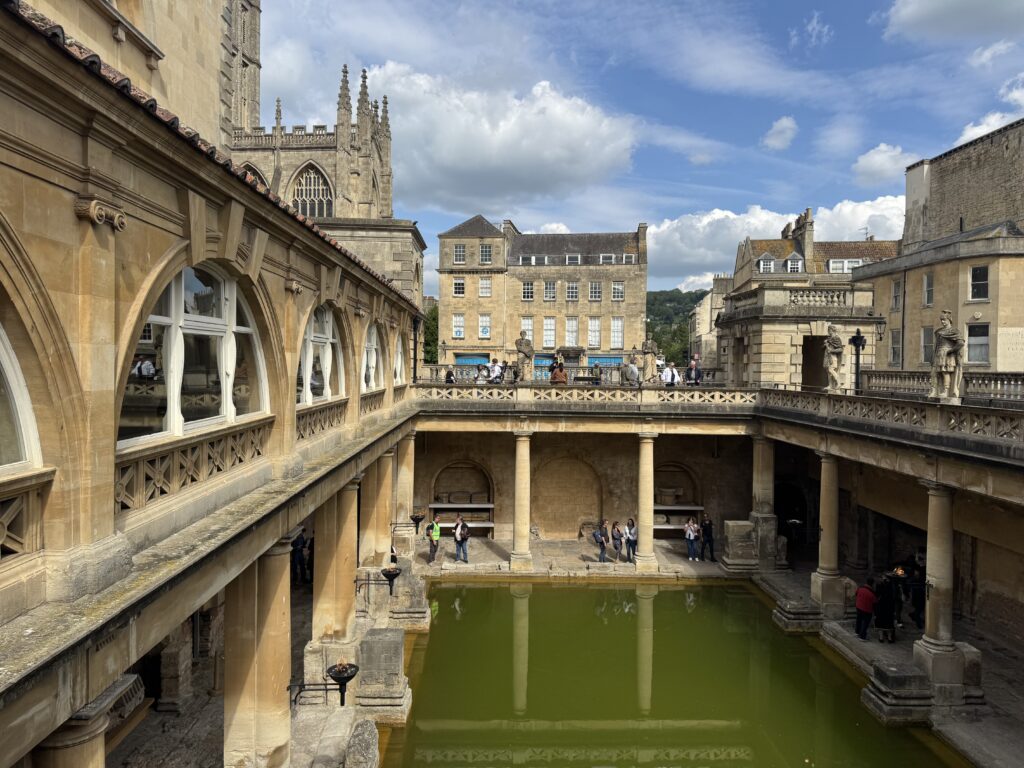
One of the first things I ever read about this historic site is that, pre-Roman British King (then Prince) Bladud discovered the spring and built the baths here because he and his herd of pigs were cured of leprosy by wading and rolling around in the warm mud associated with the Spring in 863 BC then afterwards word spread about the site and its curative powers; and people started visiting hoping to cure their own ailments. Before the building became what we know it to be today, it was a modest simpler form of a bath with a temple building. By the 4th century, the Baths and Temple of Sulis Minerva were used to their greatest extent, with the space being used by hundreds of visitors. The town was also known as Aquae Calidae meaning “hot waters.”

The centermost area that is open to the sky today, and is the most photographed is the Sacred Spring where naturally hot spring water has flowed to the site for a thousand years. The sculptor of the figures atop the courtyard area was George Anderson Lawson. From the top level of the courtyard overlooking the Bath, you can also see the beautiful, Gothic, Bath Abbey. The Roman bath building’s materials use stone, terracotta brick and lead (the bath is lined with lead sheets). Stone is the primary structure. There are marble and mosaic decorations on the walls and floors, adding visual appeal to this sought-after place.
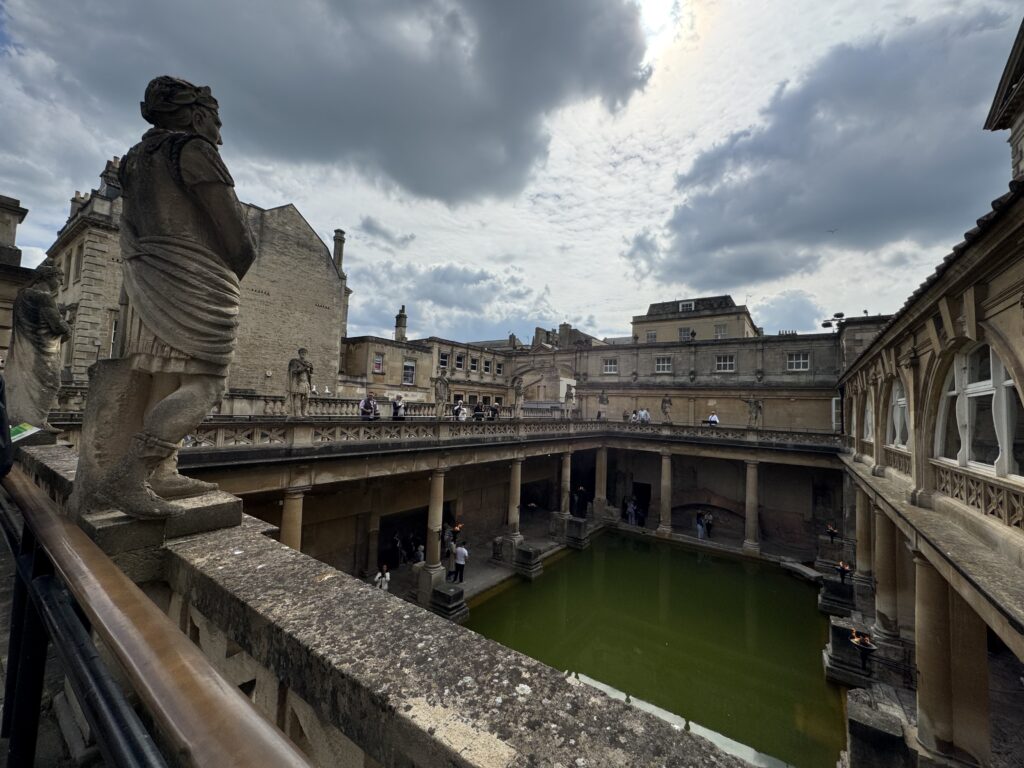
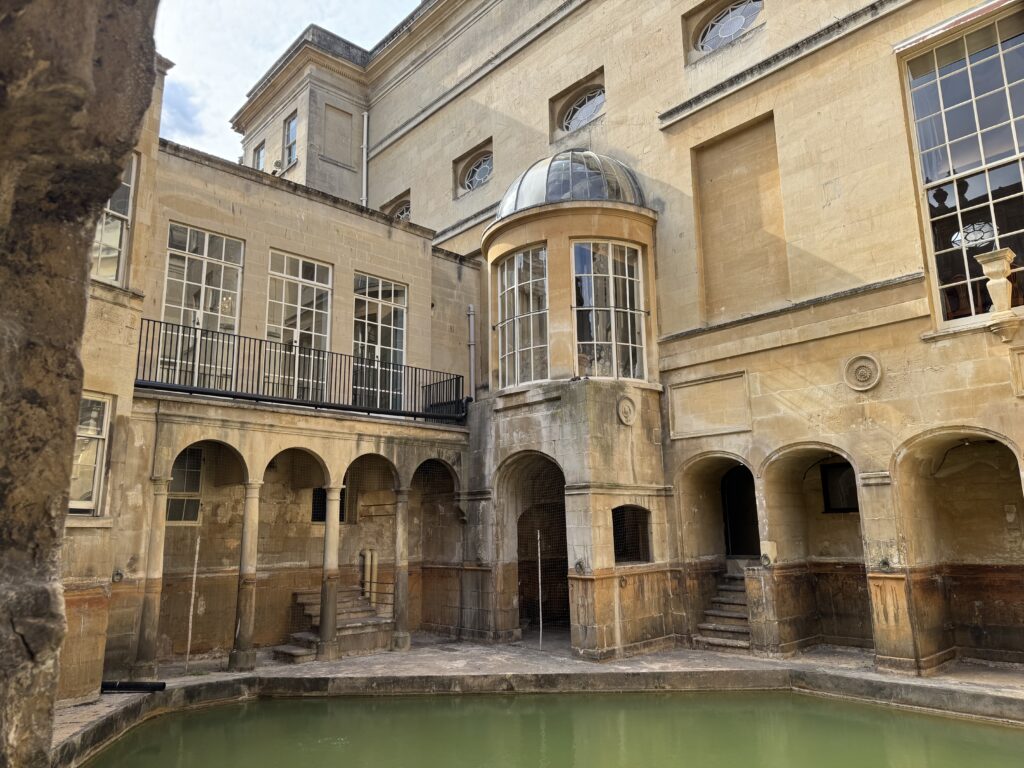
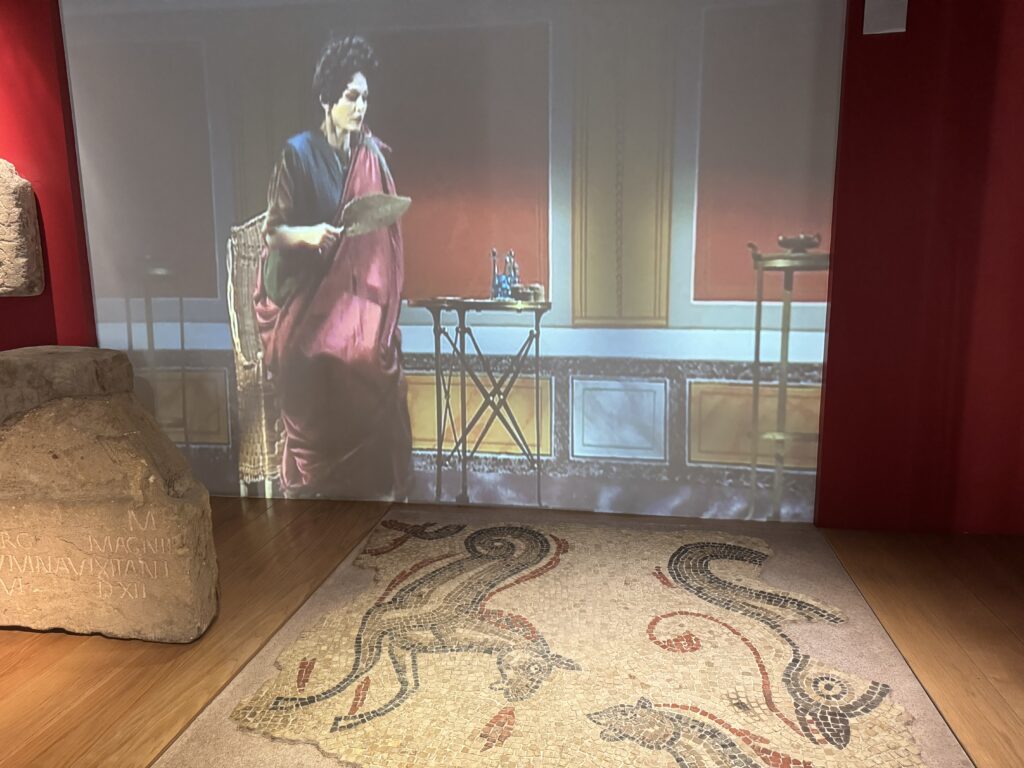
The baths were accessible to both the rich and the poor. There were common elements or features that other Roman Baths included like changing rooms, exercise rooms, open-air swimming pull, sweating rooms, a hot, warm and cool bath, rooms for massage. (citation: https://www.worldhistory.org/Roman_Baths/….) I enjoyed the projected images in the Gym area which showed how people would play ball games with each other and explained that men and women used the spaces during separate times. Special to this location was a cold-water plunge pool, educational halls, fountains and outdoor gardens. After the 1st Cent, heating systems fueled by wood-burning furnaces helped heat the water and sent warm air under a raised floor (which was then paved over and covered with mosaics). The Bath was originally ocvered by a barrel-vaulted roof 40m hi. The roof originally kept the light out which kept algae-growth at bay, which is why the water appears green today.

Some of the preserved gravestones of important contributors to the baths including craftsman are on display in the museum associated with the Roman Baths. The museum also shows remnants of original stone wall pediments and a simulation of what the wall most likely originally looked like is on exhibit as well as portions of conserved floor mosaics. The Luna pediment served as a special place for the sick to seek a cure by praying to the gods. There was also an Aesculapius which “those seeking divine help for an illness or affliction might rest overnight in special temple buildings. On waking, priests of the Roman god of healing, Aesculpaius, helped them interpret their dreams and visions.” There were carvings and an altar to aid in this purpose. Dogs were associated with Aesclepius and are carved into stone altars as well as a part of the Temple. The altar served as a place of public worship for ceremonies and animal sacrifice in the original Temple. Altarpeices on display were found in 1965 during site excavations. A quotation on exhibit is, “Sacred Spring: We….erect altars at places where streams burst suddenly from hidden sources; we honour spring of hot water as divine.” Seneca Epistulae Morales 41.3, 1st Cent AD.
Another exhibit says, “In the 12th century, the Kings Bath was built within the Roman ruins. In the 17th century, the statue of Bladud, mythical founder of the Bath, and the balustrade were added. The seat opposite known as the Master of the baths chair was donated by Anastasia Grey in 1732. In the 18th cent, the Pump Room was built. The steps, or slips outside these windows allowed bathers into the water from passages beneath the Pump Room. The ledge around the Spring is all that remains of the King’s Bath floor. The orange stain marks the former water level. In 1979, the floor was removed and water lowered to the Roman level.” Bath staff would empty and refill baths using sluice gates that were displayed which is in the shape of a frame with door that slides up and down.
Visitors are allowed to taste the water at the Baths, but I chose not to as I heard it is warm, and apparently tastes bad but people drink it because it is rumored to be healing said to ease the effects of infertility, migraines, sciatica, worms, phlegm and cramps. (Citation: https://www.tastingtable.com/…/bath-england-mineral…/) The mineralized rainwater at the springs beneath Bath comes from a limestone aquifer that is sourced from the Mendip Hills, is known for its hydrologic curative powers more than consumption however. Tastes of the water are also available from a fountain at the Pump room as well, which is a restaurant to visit after visiting the Bath.
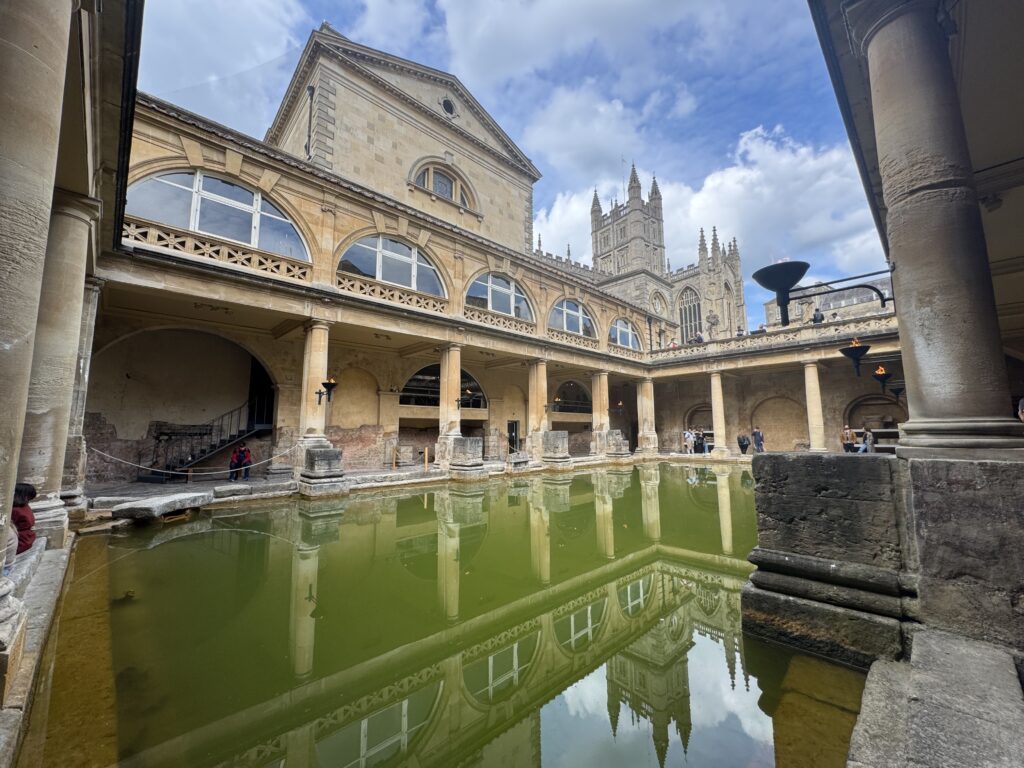
Overall, the visit was very educational and there were audioguides provided by the facility telling the story of the history of the Baths. There were models, display cases with artifacts and a lifestyle theatrical projection / movie which conveyed what early Roman life was most likely like, bringing to visitors a recreation that is very life-like. There were even actors there that were dressed in Roman clothes ready to be in a photograph and probably discuss Roman times with those who would like to. The sculptures from the 4th century were so beautiful, and awesomely ornate. There was an archeological site underneath the Bath that was also part of the experience. There was a gilt bronze head of the goddess Sulis Minerva on display that is one of the treasures of Roman Britain. This was a great historical site to visit, with interactive and engaging exhibits which allowed visitors to experience the true uniqueness of this special healing place.
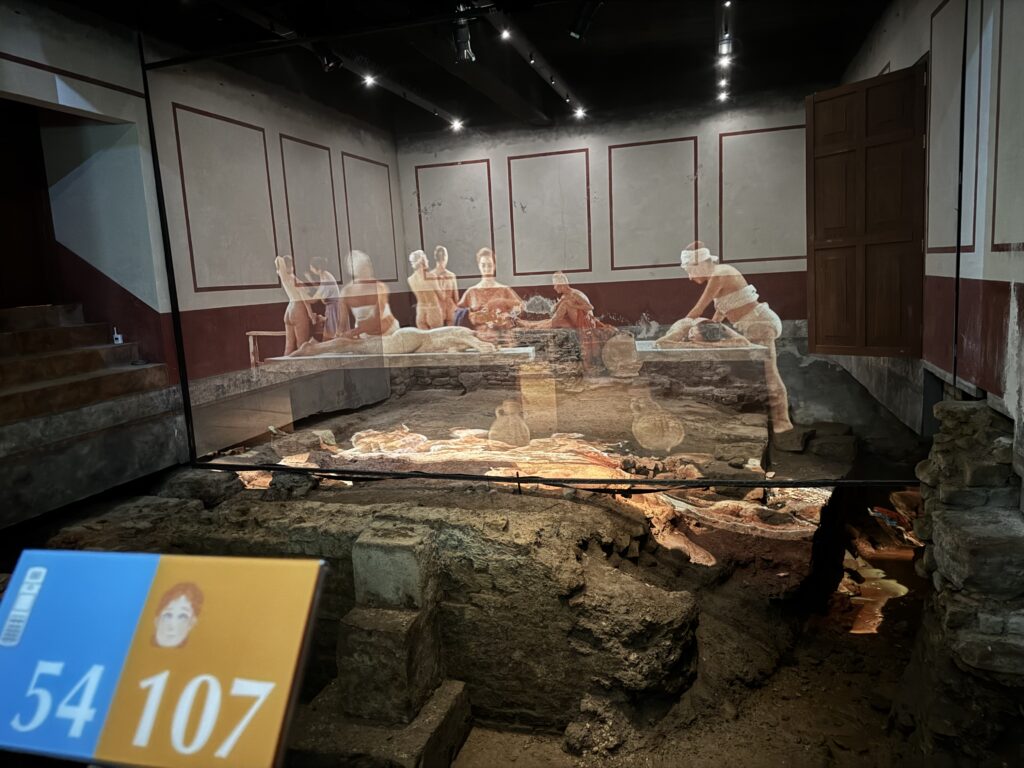
I will continue to write here about historic healing places, the next one will be about a place in Barcelona, so stay tuned!